MAKER: Sidle &. Co
MODEL: No. 2
c. 1881
SIGNED:J. W. Sidle & Co, Lancaster, PA, ACME
SERIAL NUMBER:350
AUTHOR: Barry Sobel, with the assistance of Brian Stevenson
Editor: Joseph Zeligs
Please Click On Any Picture for a Larger Version
DESCRIPTION:
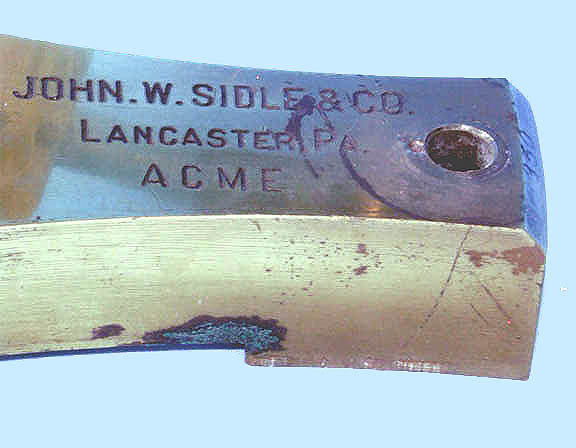

This is a large monocular Lister-limb microscope which is about twenty inches in height in the working position. It arises on a single pillar from a flat lead-filled brass tripod foot with short toes, engraved:
John W. Sidle & Co., Lancaster PA, ACME.
The toes of the foot have chamfered distal edges. On the toe with the Sidle signature, the chamfered edge bears the serial number of 350. The foot has holes drilled through each toe for bolts fitted into holes on the wooden base with screwed-on knobs securing it to the base.
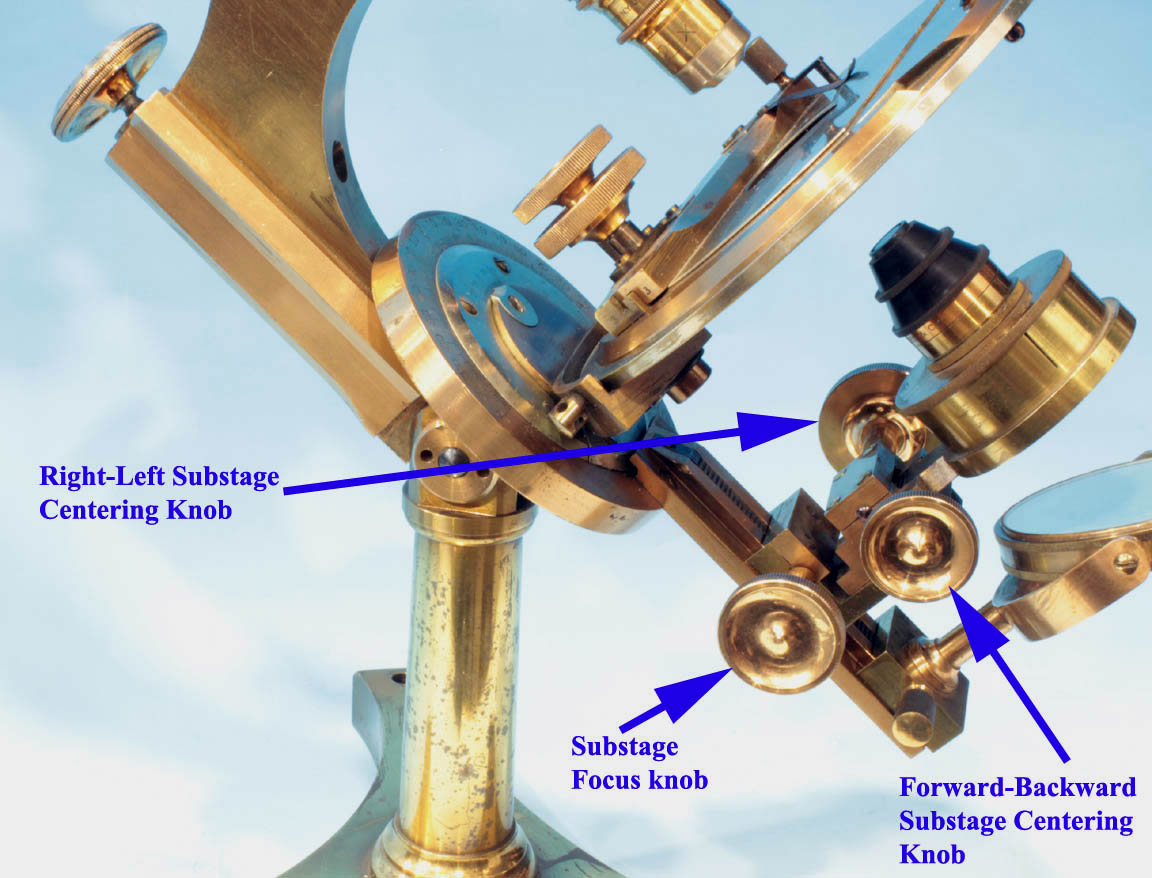
The tailpiece carries the mount holding a plane and concave mirror which is gimbaled, and also the condenser mount. The mirror fitting can be pushed up or down the tailpiece. Small handles would facilitate moving the mirror sliding up or down the tailpiece, and although the one on the left side of the mirror slide is present, the one on the right side is missing. The substage is focused by rack and pinion. Both the substage fitting and the mirror fitting dovetail onto the tailpiece with thin leaf-springs on one side of these fittings to keep the movement on the tailpiece tight.
The substage ring support of the substage can be centered via two knobs. The knob on the right side of the substage controls right-left motion, the knob on the left side controls forward-backward motion. The forward-backward movement is via straight-toothed rack and pinon. Right-left motion (in an arc) is controlled by the screw from the knob on the left side. The way this works is detailed on the substage page.
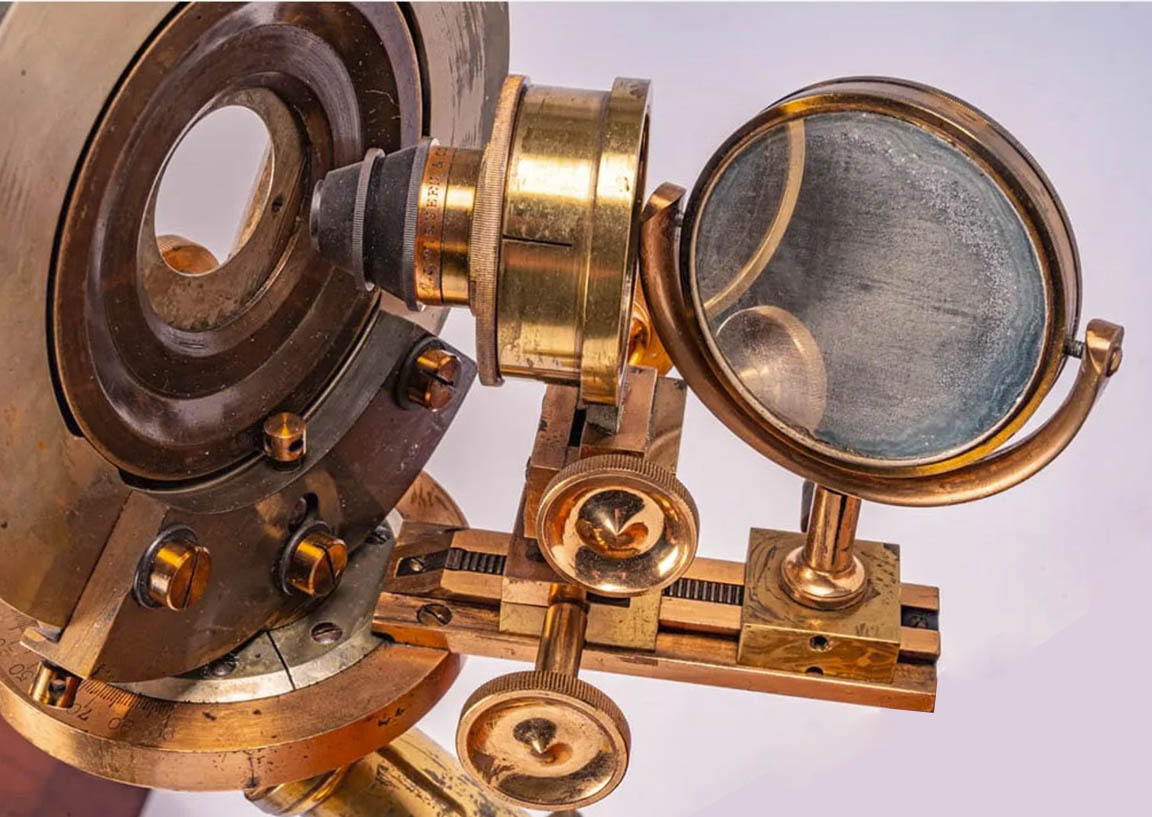
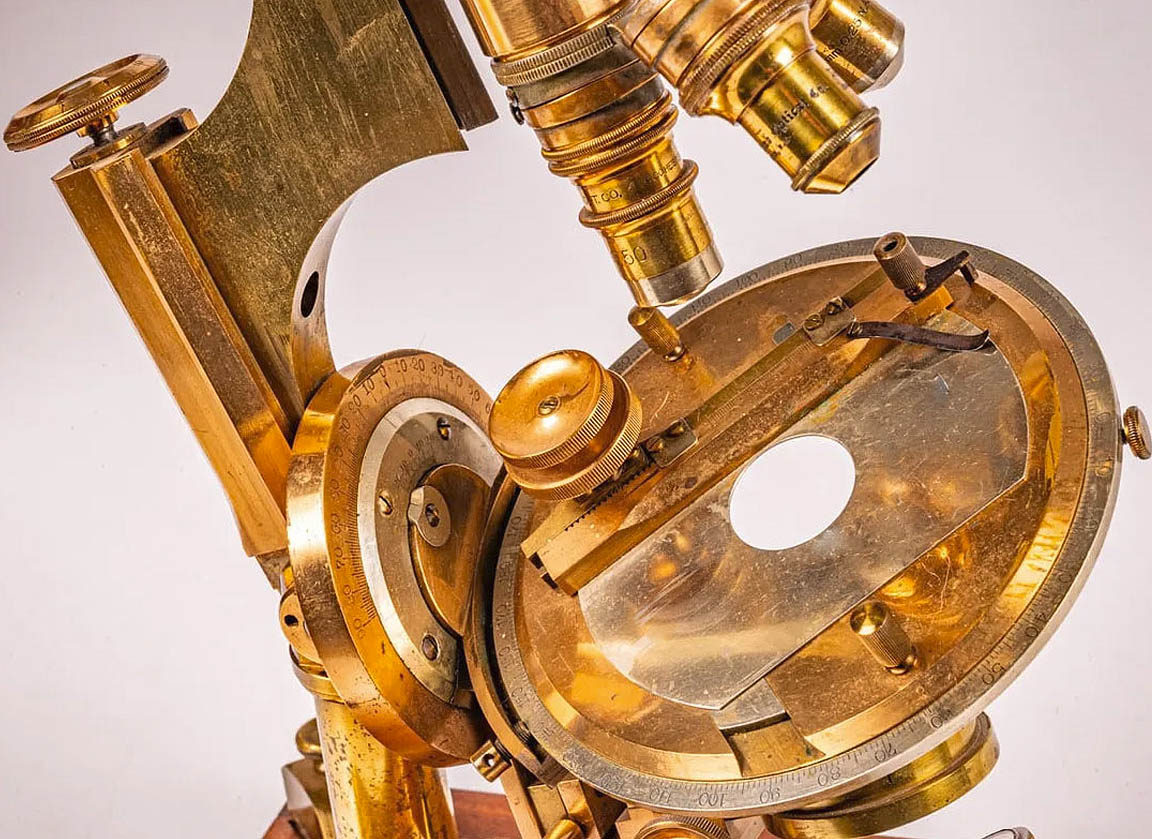
The swinging substage(left), has a condenser mount that has centering controls for the condenser mount on the right and left side for forward-backward and right-left movement respectively. The tailpiece is attached to a calibrated lacquered brass sector disk, shown to the right, the center of rotation of which is concentric to the horizontal plane of the top of the stage. The sector disk has a 3 3/4 inch diameter and the disk is calibrated in single degrees, labeled every ten, from 0 to 90 degrees to the right and also to the left. An additional central alloy or nickel-silver(German Silver
) disk, is calibrated in single degrees labeled every 5 degrees, and indicates tilting of the stage and is calibrated from 0 to 20 degrees in both directions.
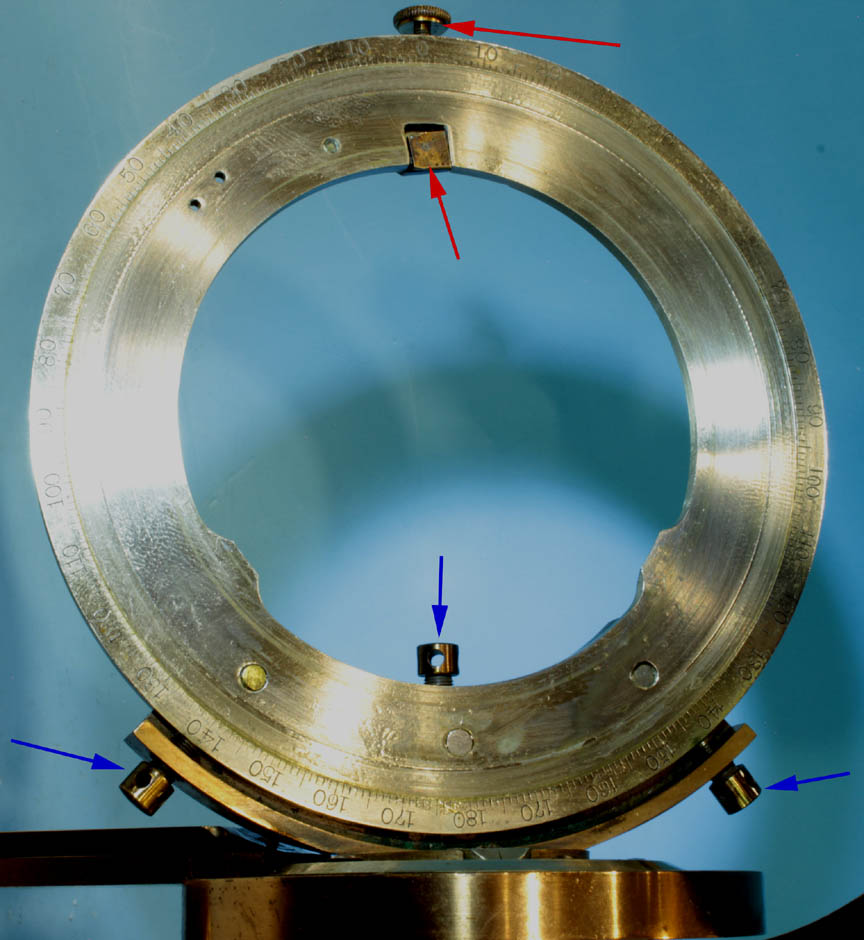
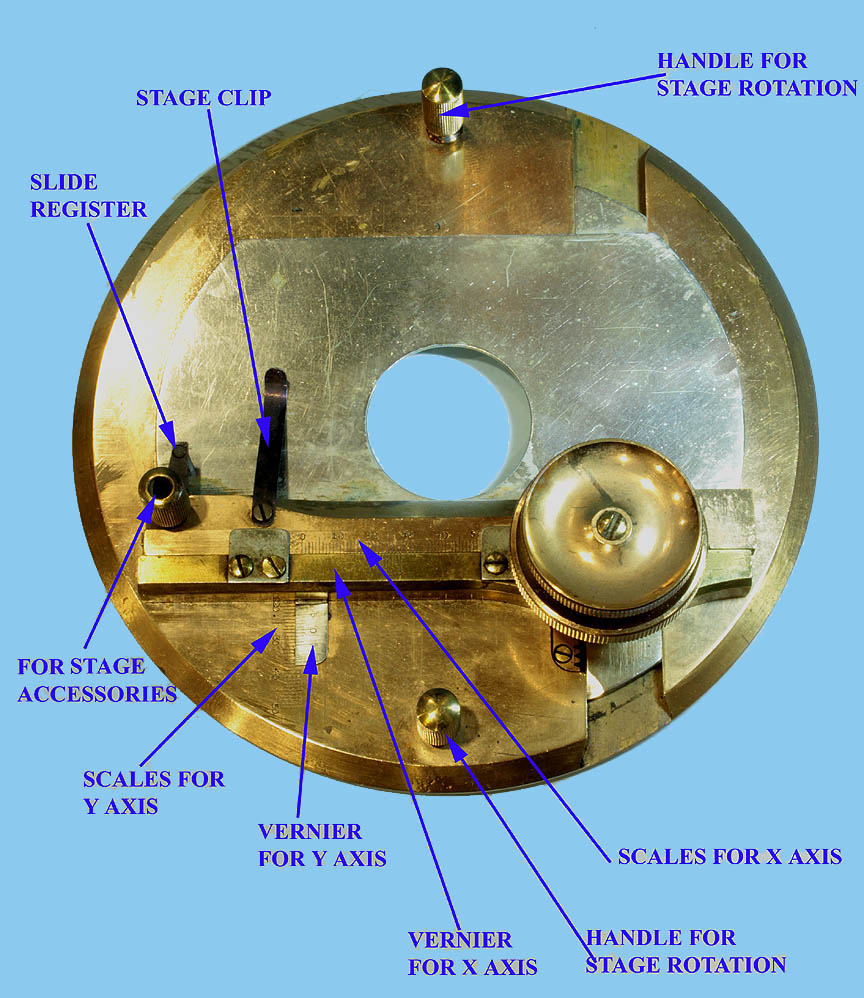
The mechanical stage sits in a nickel-silver ring (left), is engraved with calibration marks. The stage ring has provisions for centering in the optical axis via 3 capstan screws, 2 on either side of the rear of the stage, and one inside the ring acting the opposite direction. The mechanical stage is a type controlled from above with concentric controls for motion. This stage has the same type of controls as the stage provided by Bulloch on his better microscopes starting about 1882, and also the type provided on the Tolles-Boston Optical Works A-stand
constructed by C.X. Dalton in 1886. Bulloch stated that this form of mechanical stage was invented by Charles Spencer many years earlier. The mechanical stage can rotate on its vertical axis 360 degrees against its calibrated ring. It is calibrated in single degrees, labeled every ten and ranging from 0 to 360 degrees.
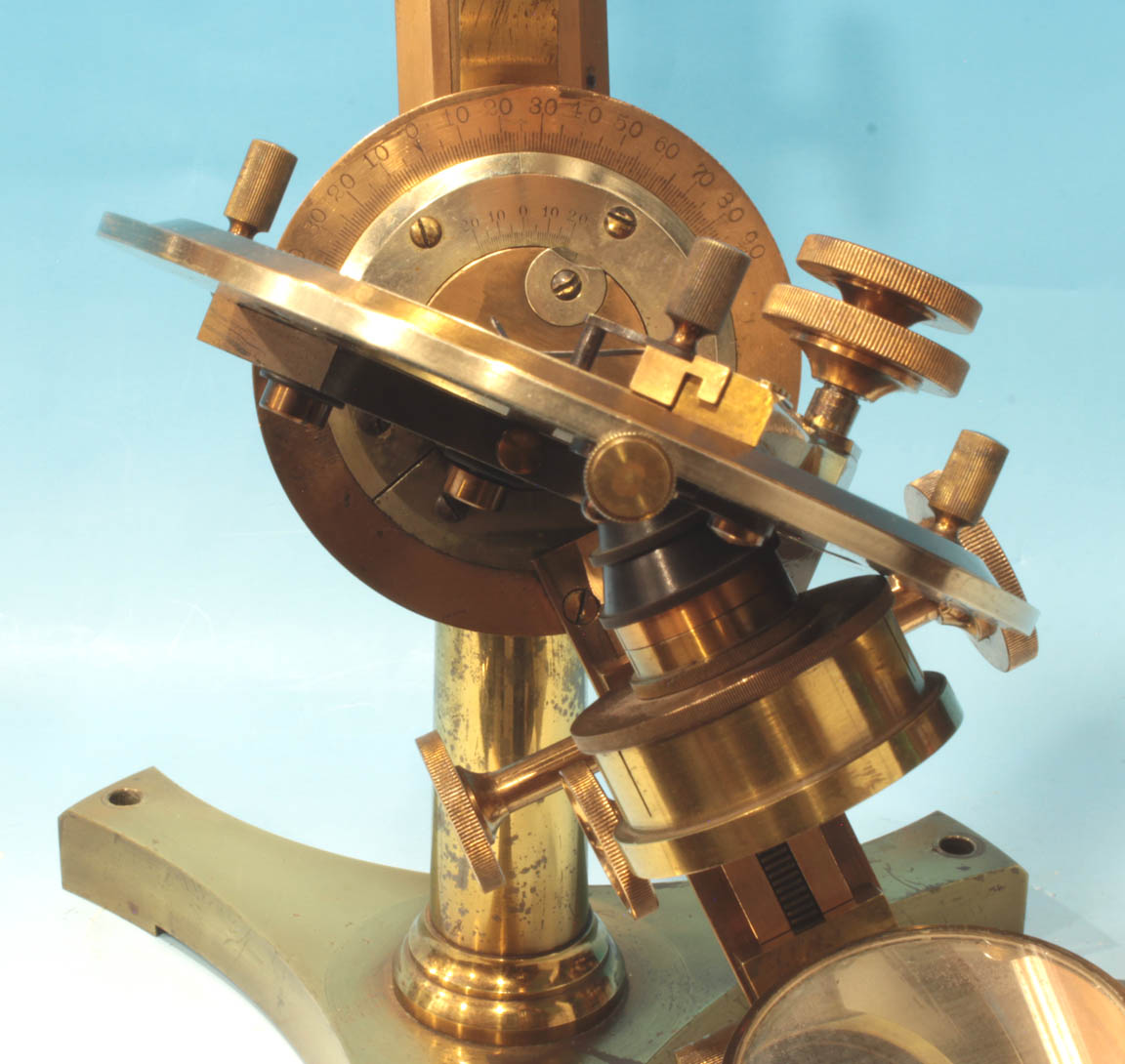
The facility to tilt the stage right or left, on a horizontal axis separately from the substage allows a variety of oblique illumination options. It can even be turned over so that the slide is then on the bottom, permitting even more extreme oblique illumination.
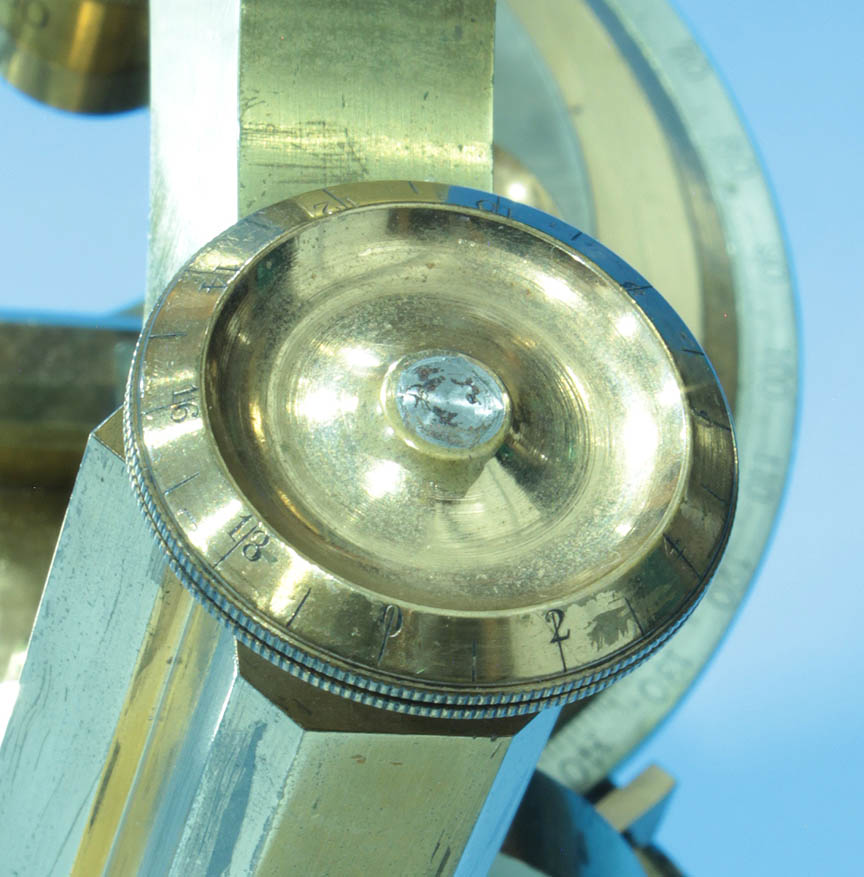
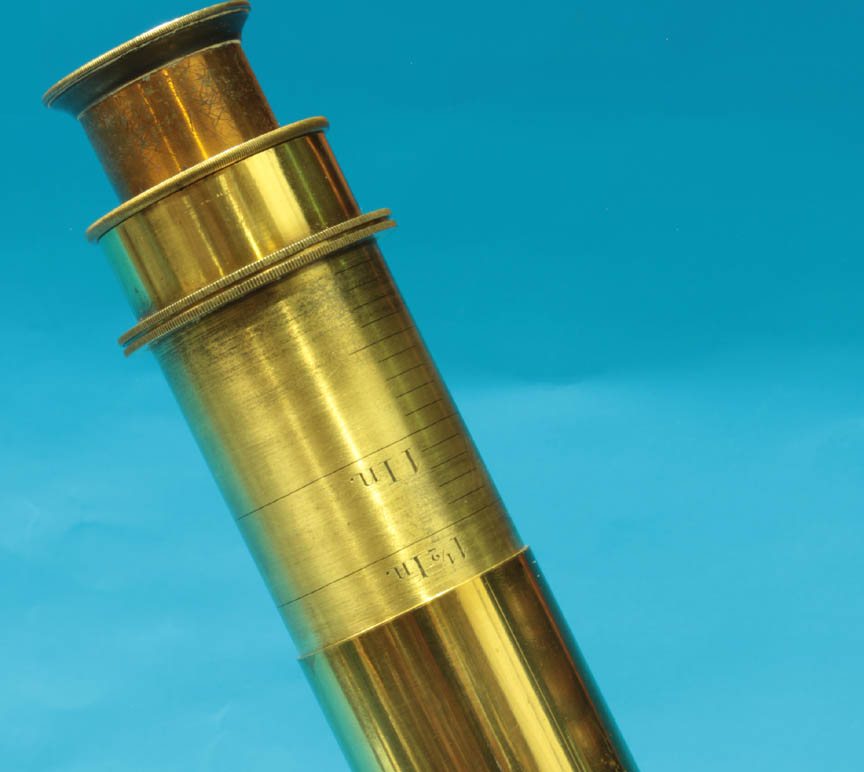
Coarse focus is by straight-toothed rack and pinion. Fine focus is by a calibrated knurled knob, acting on a long lever through the limb. The main optical tube is 8.5 inches long. The draw tube can be extended 7 inches. It has calibrations up to 1 1/2 inches, with engraved marks every 1/5 inch and labeled at 1 inch and 1 1/2 inches. This provided tube lengths to fit the standards of the time; the earlier 10 inch tube length or the later Bausch & Lomb tube length of 8.5 inches. It is notable that it did not provide the shorter 6.3 inch tube length of Continental makers.
ACCESSORIES:
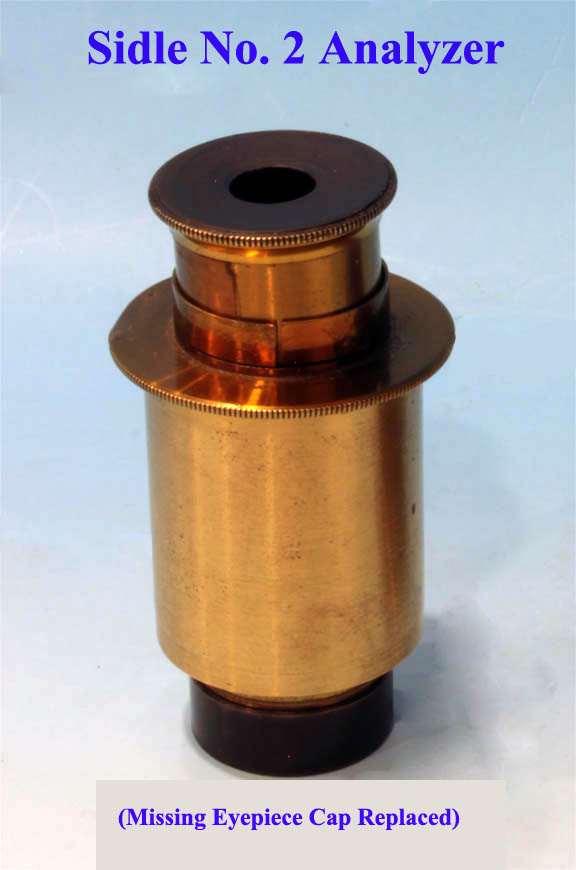
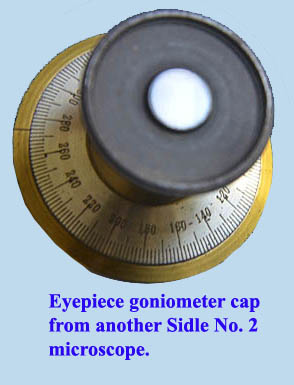
Accessories include the original case, a Queen substage condenser, a substage paraboloid darkground condenser, a selection of Bausch & Lomb objectives, and a Bausch & Lomb triple nose piece. The original eyepiece analyzer (shown to the left) is present. When received it had was missing its eyepiece cap and a period replacement has been added by the author. A period substage polarizer and nosepiece analyzer have been added to this set. A well-fitting regular period eyepiece has also been added. The case most likely had an accessory case which fit inside the main case, but the accessory case is now missing, as are other accessories such as a bullseye condenser on stand, etc.
CONDITION:
The microscope is in good operating condition with spotting to the lacquer on the pillar, and scattered mild losses elsewhere. The small handle on the right side of the mirror slide is missing. The mirror has mild deterioration of the reflective surface. As previously noted, holes have been drilled in the foot to secure it to the screws in the wooden slide of the case. The case itself has warping to the bottom and the dovetail joints of this piece are somewhat loose.
HISTORY OF SIDLE AND POALK, SIDLE & COMPANY, ACME, AND QUEEN MICROSCOPES:
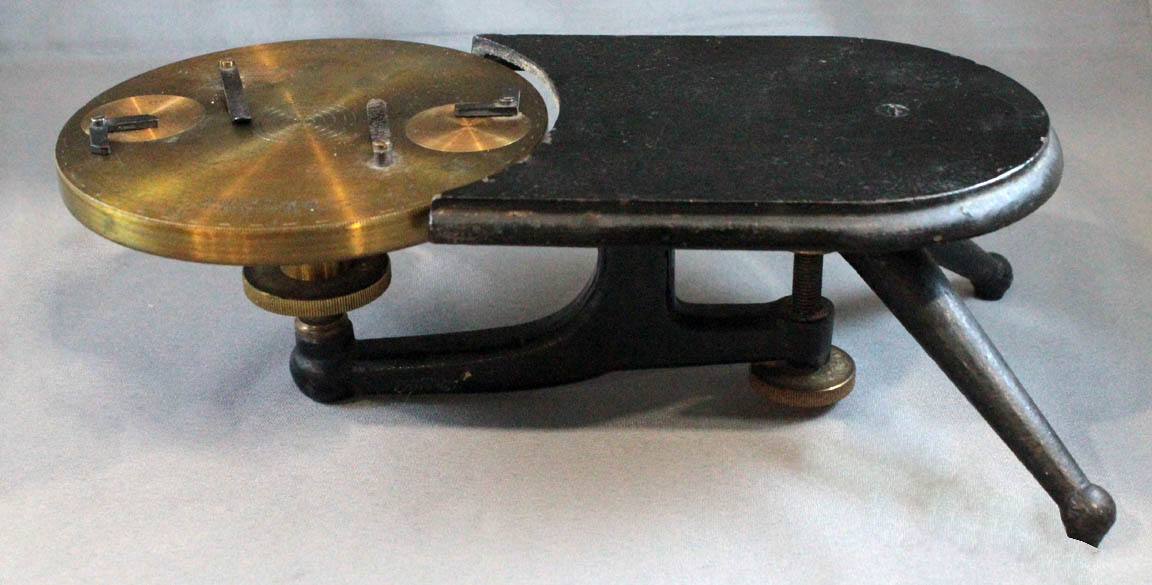
Sidle and Poalk was a firm in Philadelphia, Pennsylvania. John W. Sidle of that company attended the American Microscopical Congress in Indianapolis, Indiana in 1878. There he exhibited his Congress
model slide-ringing turntable(right) and met with professor J E Smith, another attendee of the Congress. Smith and Sidle worked together to come up with inexpensive, yet more mechanically sound microscope designs to compete with lesser quality stands then being sold by other makers1.
According to Padgitt, the first Sidle and Poalk stands were sold in August of 1879, quickly followed by redesign and production in 1880. G.S. Woolman exhibited the ACME microscope by Sidle and Poalk at a meeting of the New York Microscopical Society on November 21, 1879. In the 1880 census, John W Sidle was listed as living in Philadelphia and his occupation was listed as Optician
, while Poalk was listed as a Machinist
, also in Philadelphia but at another address. Although Sidle's Acme stands have been thought of as basic
models, the No 2 stand (see below) was a very sophisticated model capable of most advanced work.
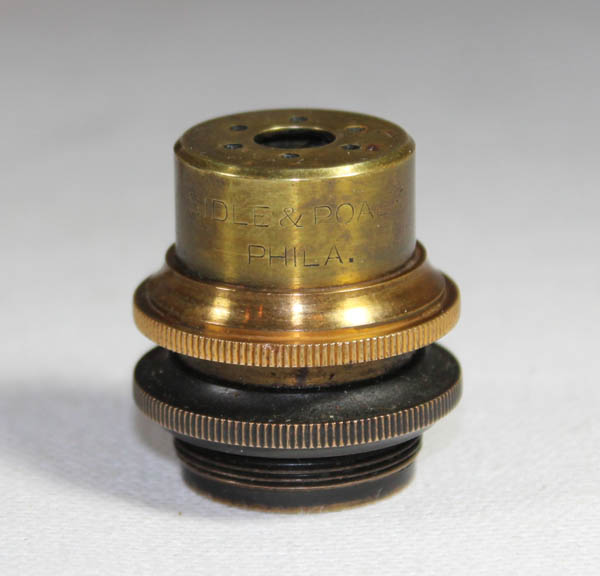
Sidle and Poalk also designed a compact iris diaphragm (left), reported in the JRMS of 1880.
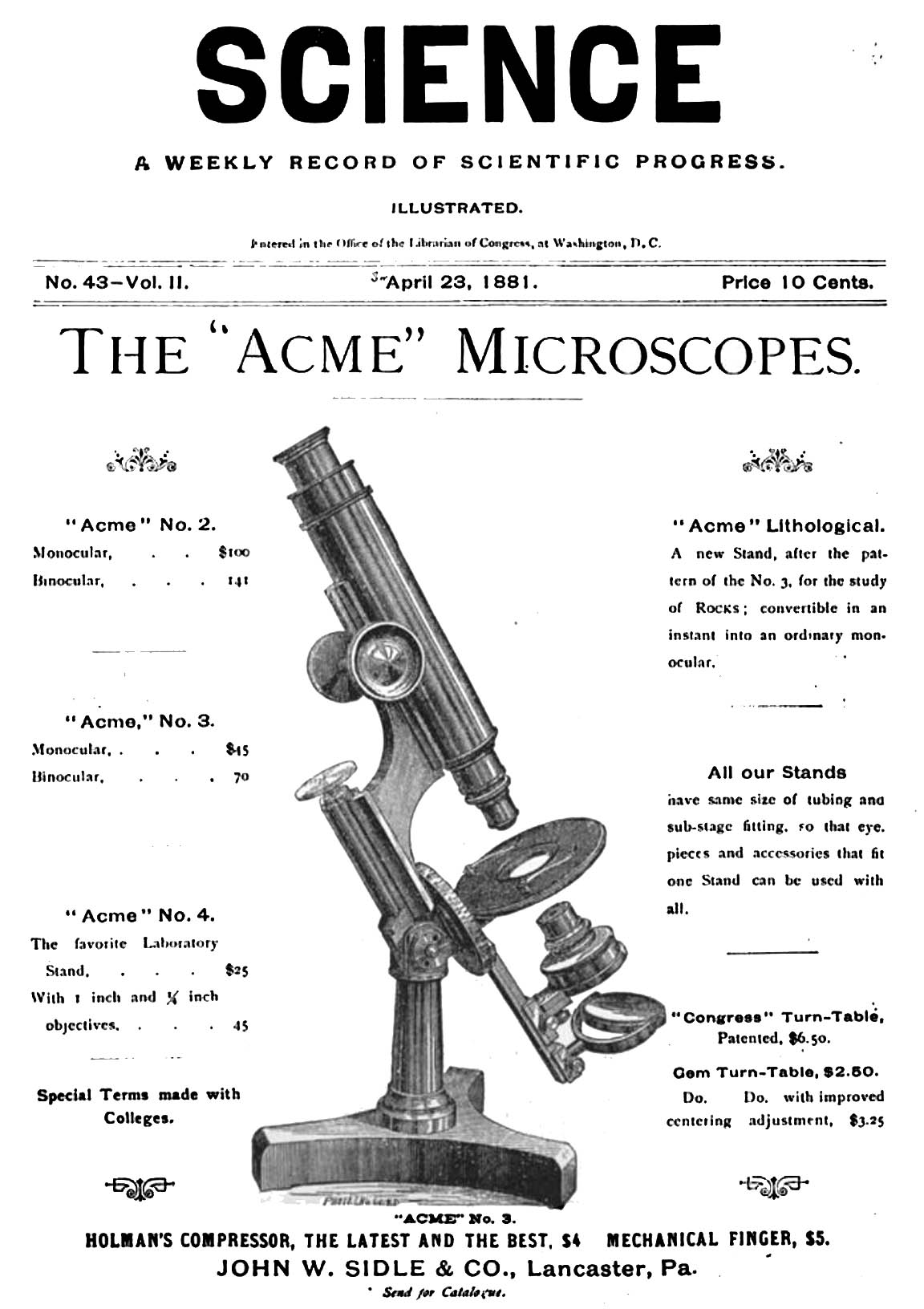
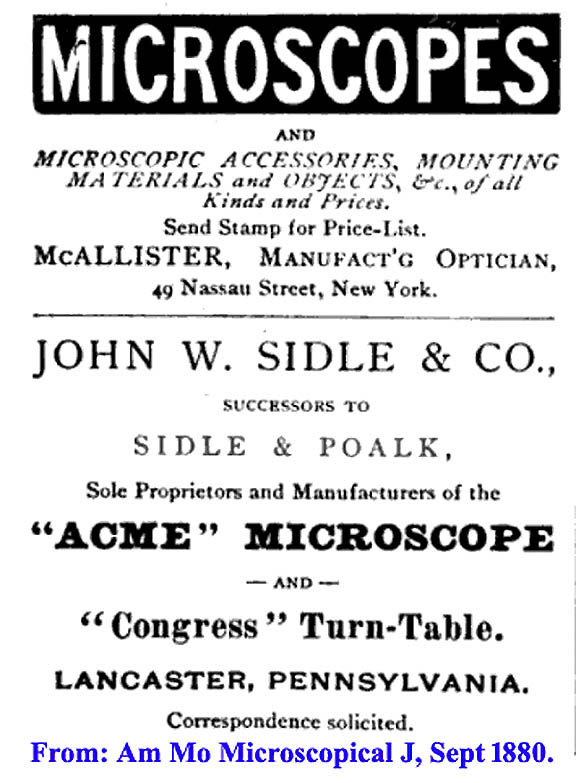
By that summer though, Poalk apparently left, and Sidle moved to Lancaster, Pennsylvania; there the company was renamed John W. Sidle & Company
but also became known as the Acme Optical Works
. An ad in the American Monthly Microscopical Journal of September of 1880(right) announced John W. Sidle & Co as successors to Sidle & Poalk, Sole Proprietors and Manufacturers of the 'Acme' Microscope -and- 'Congress Turn-table, Lancaster Pennsylvania.
Interestingly, in the same issue, G.S. Woolman of New York City advertised he was selling the Acme Microscope. Four different stands were offered by Acme at that time. Sidle & Company advertised the No. 2, No. 3, No. 4 and the Lithological models in the Journal Science in April of 1881.
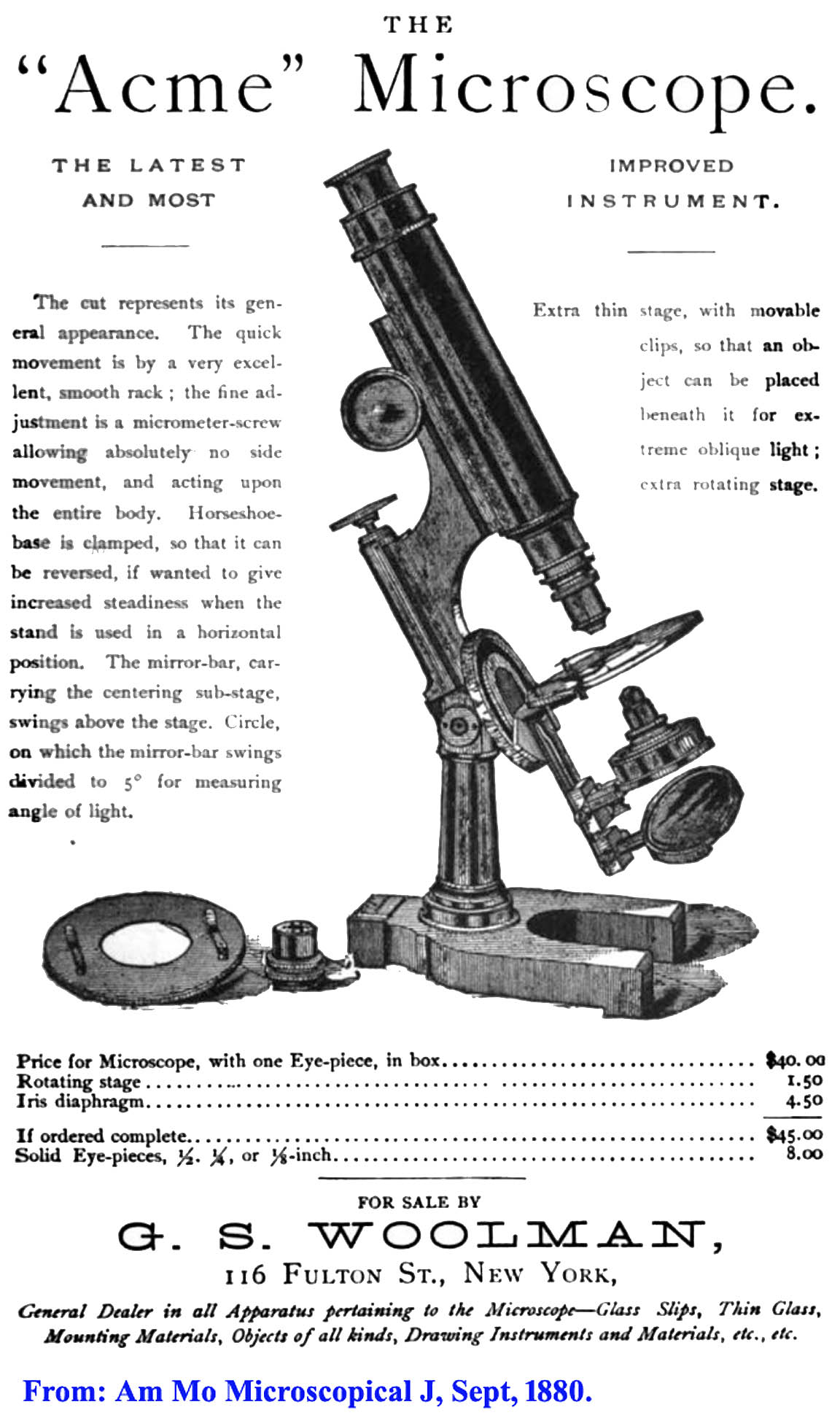
As noted in the paragraph above, Acme
microscopes made by the Sidle company were also sold by agents such as G.S. Woolman, a retailer (noted above and illustrated to the left), and Herbert Spencer, who himself mainly made objectives.
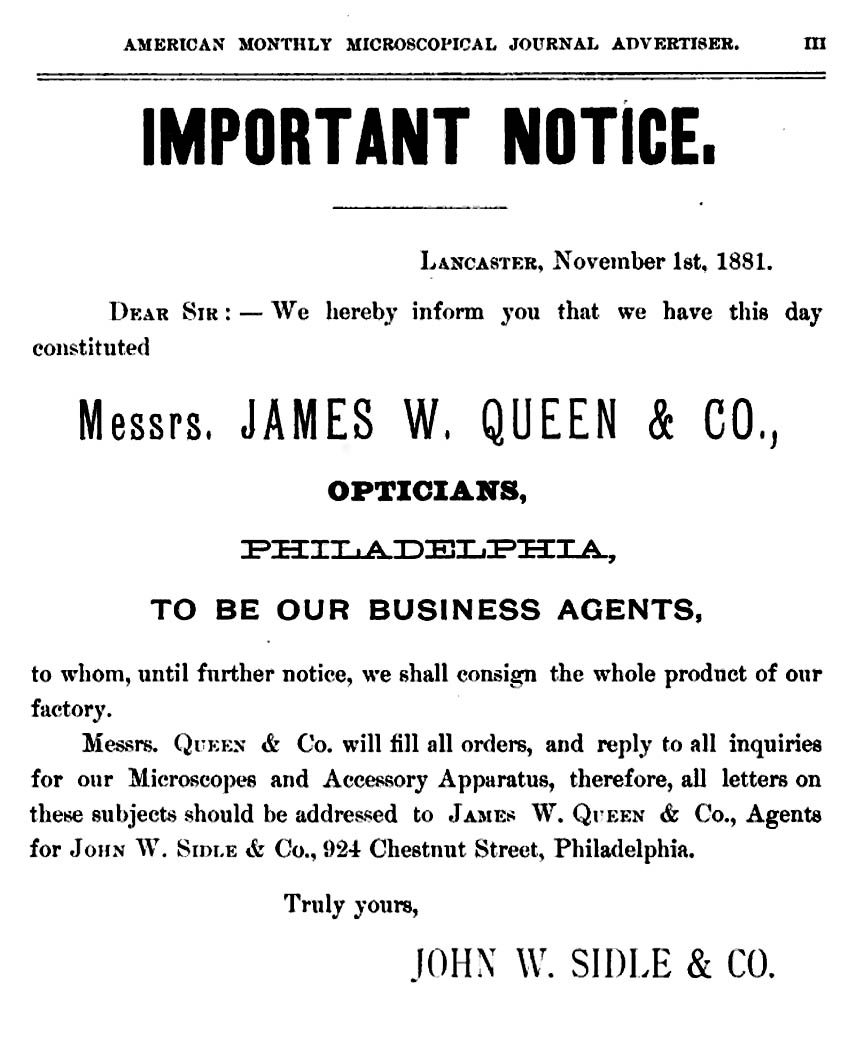
But in a notice dated November 1, 1881, Sidle decided to consign the whole product of our factory
solely to Queen of Philadelphia and the Acme brand was from then on sold only by Queen. In that same year, the famous number 4 stand(see below) was described in the JRMS. Later that same year the Sidle-Acme Lithological microscope model was also described in the JRMS of 1881, pages 937-939.
According to Deborah Jean Warner, a Queen publication of 1886 indicates that Queen took over production of the Acme microscopes by 1886. According to Sidle advertisements, he started making Telescopes and Telescopic Rifle Sights starting about 1888. In 1900, Sidle was listed as an instrument maker in Philadelphia. In 1908 he moved to Corning, California where he continued to make telescopes and telescopic sites and hunting glasses
. The census of 1910 states his occupation as machinist. He apparently continued this enterprise until shortly before his death on December 23 of 1918 when he died in Agnews in Alameda County, California. The quality of Sidle Gunsights and rifle sights was praised in publications for decades after his death.
The Queen company was quite large and became a training ground for many people who formed their own companies including Edward Pennock, Williams, Browne & Earle (WBE, 1885) and Arthur H. Thomas(1899). William H Walmsley and Jesse Cheyney also left Queen to form their own companies. Small student microscopes signed by WBE, and Walmsley are in this collection.
A REVIEW OF THE VARIOUS ACME
MICROSCOPE MODELS
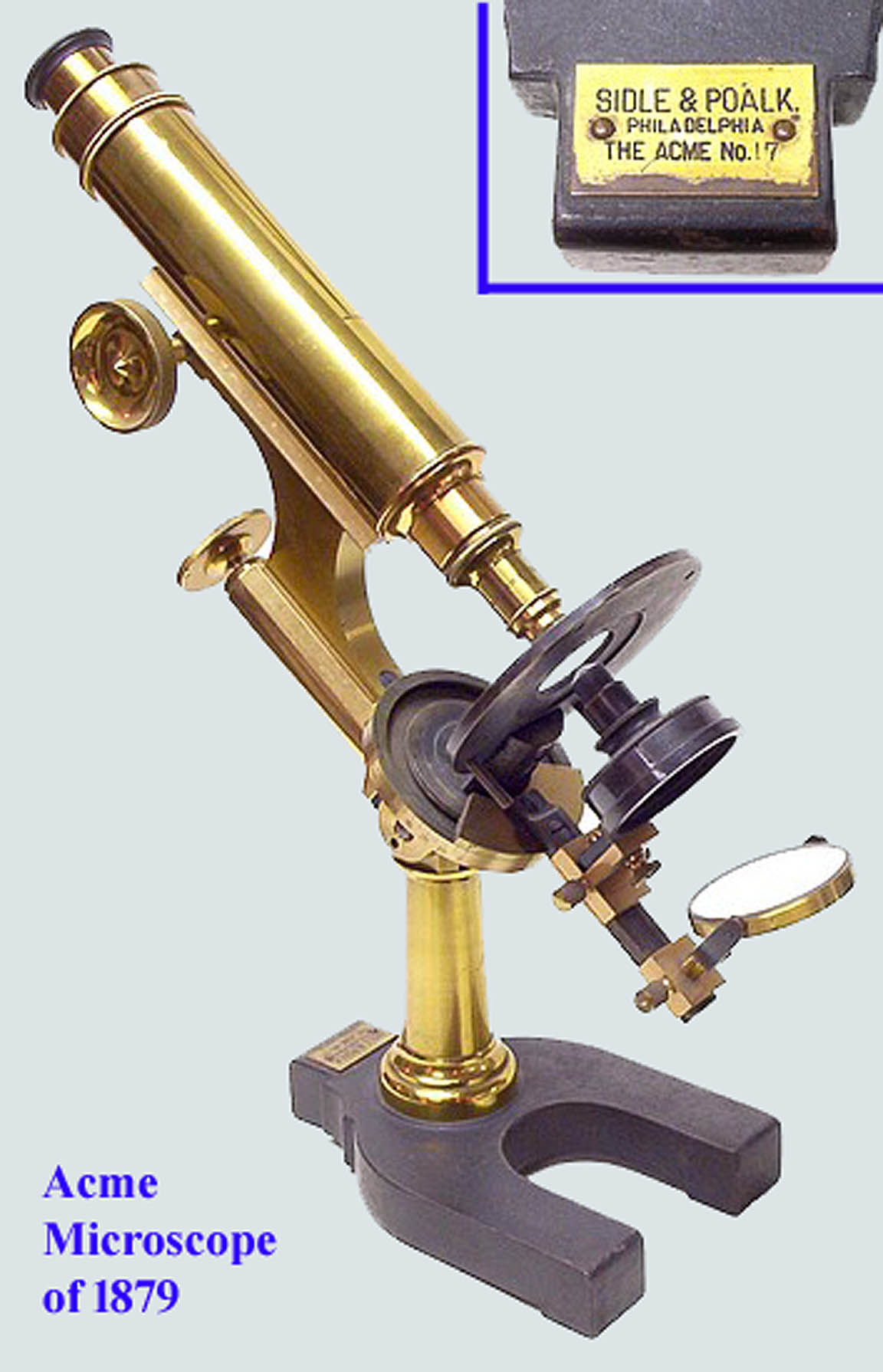
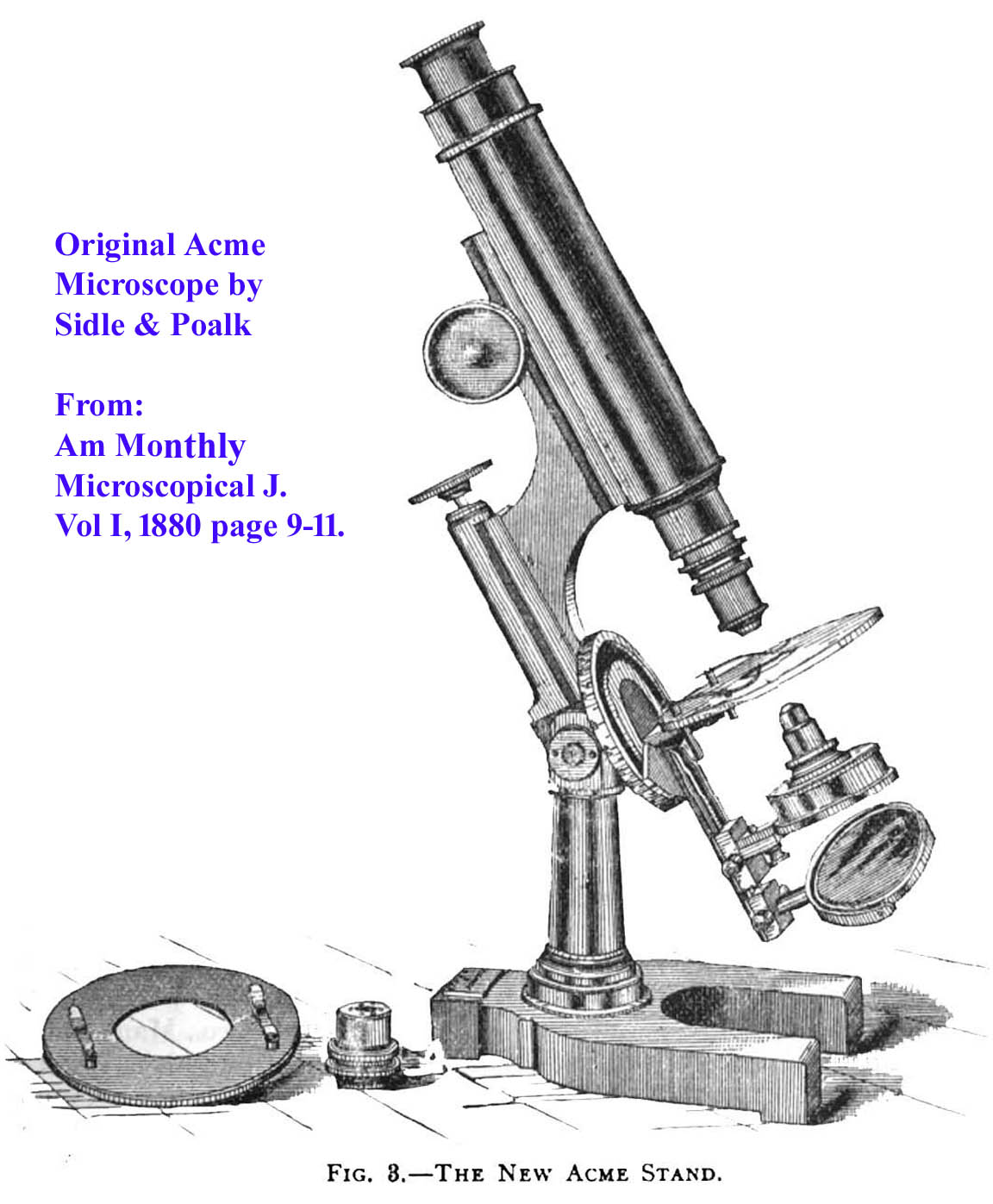
The earliest microscopes known to be made by Sidle & Poalk date to 1879. In August of that year, Professor E.W. Smith exhibited for the first time, at the 2nd Annual Meeting of the American Society of Microscopists, the Acme microscope made by Sidle and Poalk.
Shown to the left is a microscope from the Wissner collection, signed by Sidle & Poalk on an applied plaque. It likely dates to that year. It was simply called the ACME
. It was first described and illustrated in detail in the American Monthly Microscopical J in the January issue of 1880, Volume 1, pages 8-10.
It was also reported in the JRMS slightly later in 1880 on page 522-3. There it stated that it was the first cheap instrument we have seen with a swinging substage
. This microscope was reported to have a reversible horseshoe foot for increased stability when used in a horizontal position. It also notes the stage could be centered. Other examples of this microscope have the slightly later engraved signature of John W. Sidle and Co on a flat tripod foot, apparently dating to after Poalk left the firm in 1880.
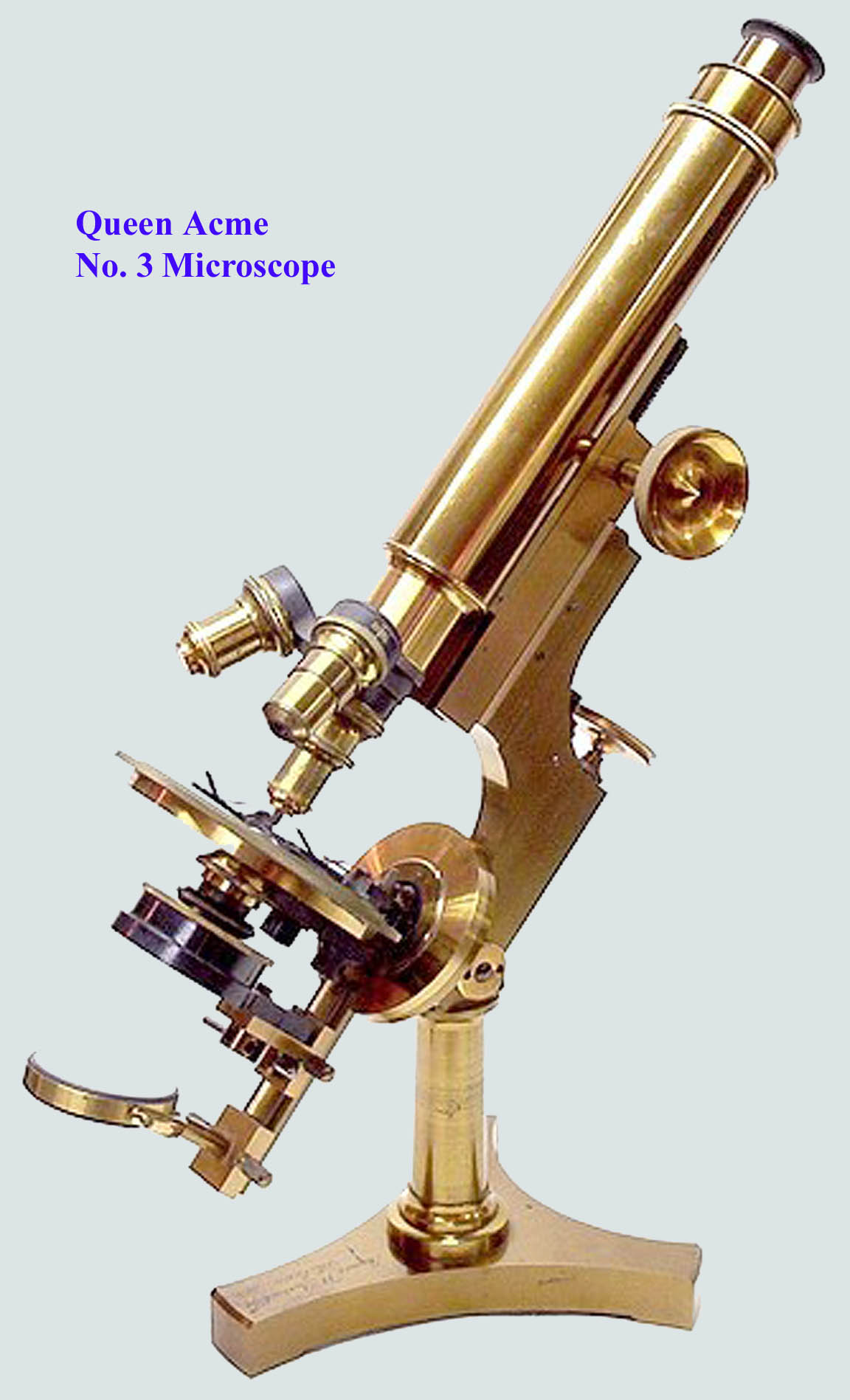

This is an example of the Acme No. 3, which is quite similar to the original Acme model pictured above, with some changes. It was advertised as early as 1880. As this model evolved, the sector was now graduated on its face, rather than its edge and it was then finished in lacquered brass. The limb was a sturdier form than the original model. There were at least two variants of this model, one having capstan-type set screws for adjustment of centering of the substage, the other variant had no provision for adjustment of the centering of the substage. It was pictured in the Queen catalog of 1883 as the New Model No. 3
, where it can be seen that the design of the limb had changed, and, a simple stage that had previously been provided for this model could now be instead equipped with a glide stage, which could rotate, as well as the Penncok adjustment to center to substage, which is seen on the page on Allan Wissner's Website. Coincidentally, Beck came out with a similar microscope, the Ideal model, reported in the JRMS of May, 1881, pages 805-807.
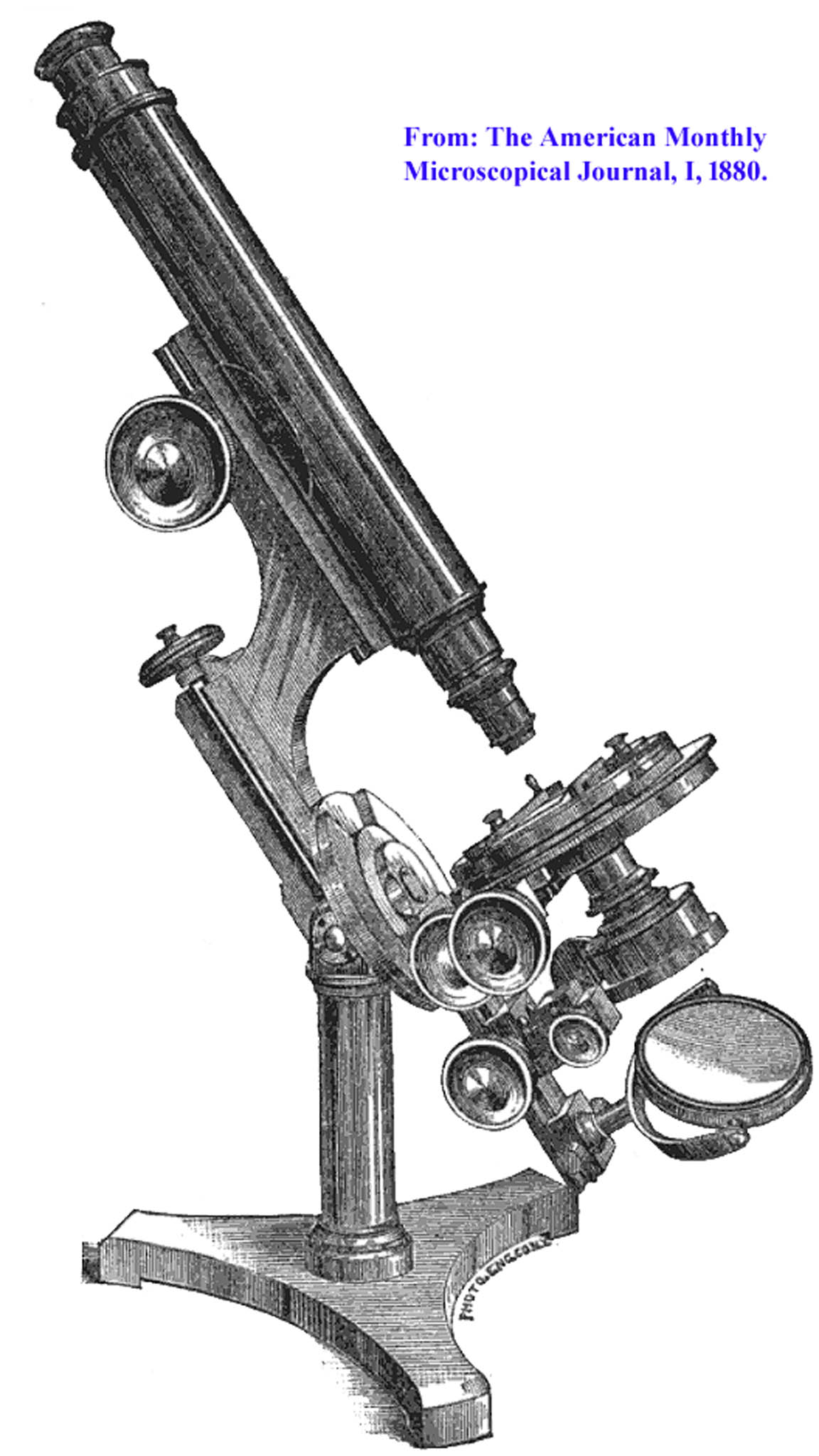
The Acme No. 2, featured on this page, was first illustrated and described in detail in the Am Monthly Microscopical J, Vol I in 1880 on pages 203-204. It was described as larger than the No. 3. It was originally sold with a choice of stages with glass surfaces. This included a mechanical and rotating stage, with the mechanical stage controls oriented horizontally as seen in the illustration to the left. It also featured the new Sidle centering substage which was itself later reported in the JRMS of 1882, volume II, Page 555. The centering substage had knobs on the right and left side, whereas examples of centering substages by most other makers had one knob in front and one to the side. This newer centering mechanism worked by rack and pinion for the forward-backward direction and by a screw for the right-left direction. Rack and pinion control of centering the substage is a very uncommon feature.
Bulloch used a similar method on some of his better stands like the Congress model. In addition, there was provision to center the stage. The example featured at the top of this page, has a newer mechanical stage with controls oriented vertically, allowing the stage to rotate a full 360 degrees. In addition the sector design is the slightly new version, the prior version, seen in the first description of the No. 2, was quickly changed to the one seen at the top of this web page. The other example of this microscope I am aware of had this same sector and stage. To my knowledge, the centering of the substage and stage was never offered or illustrated in the Queen catalogs, and neither was the No. 2 stand itself. In fact, there is no other illustration of the Acme No. 2 that I am aware of. Accessories for this model included a substage polarizer and goniometer analyzer eyepiece with centering crosshairs, at least with the two examples I know of. Unlike the Lithological model, no analyzer or Klein plate sliders were incorporated into the main optical tube; an accessory eyepiece analyzer was used for this purpose instead. Alternatively, a screw-on nosepiece analyzer could be used with this microscope.
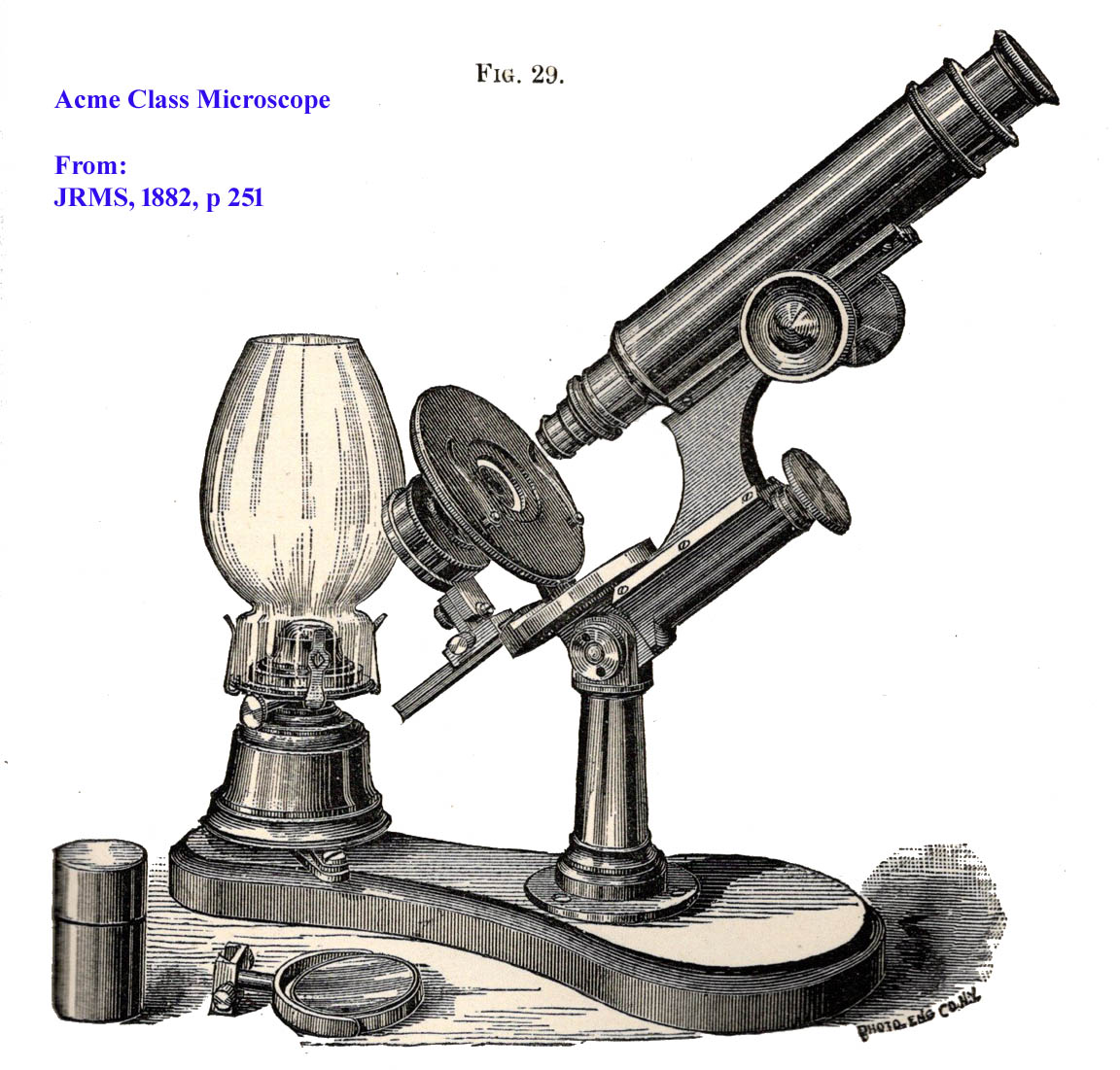
The Sidle Acme Class Microscope
described in the JRMS 1882, was a simple adaptation of the original Acme model attached to a wooden board instead of a tripod foot and at the other end of the board a round platform for a small kerosene lamp on a swivel. It was not listed in the Queen catalog of 1883, with the very similar Holmes model by Beck listed instead. An example of a Sidle/Acme/Queen Class microscope that was based on the early version of the No. 4 rather than the first Sidle Acme Microscope, is in the science museum. It is signed MADE BY, ACME OPTICAL WORKS, JAS W. QUEEN & CO, PHILADELPHIA, AGENTS
. It is also signed on the microscope stage: JOHN W.SIDLE & CO.,LANCASTER PA., ACME, 112. Since the early No 4. was produced starting about 1881, it may date to around 1881-1886 The illustration in the JRMS of 1882 may already have been out of date when it was published. It is unlikely to date to after 1886, since by that time, Queen had taken over production, no longer being agents. The low serial number also places this in the early days of Sidle's production in Lancaster, which started in the Summer of 1880.
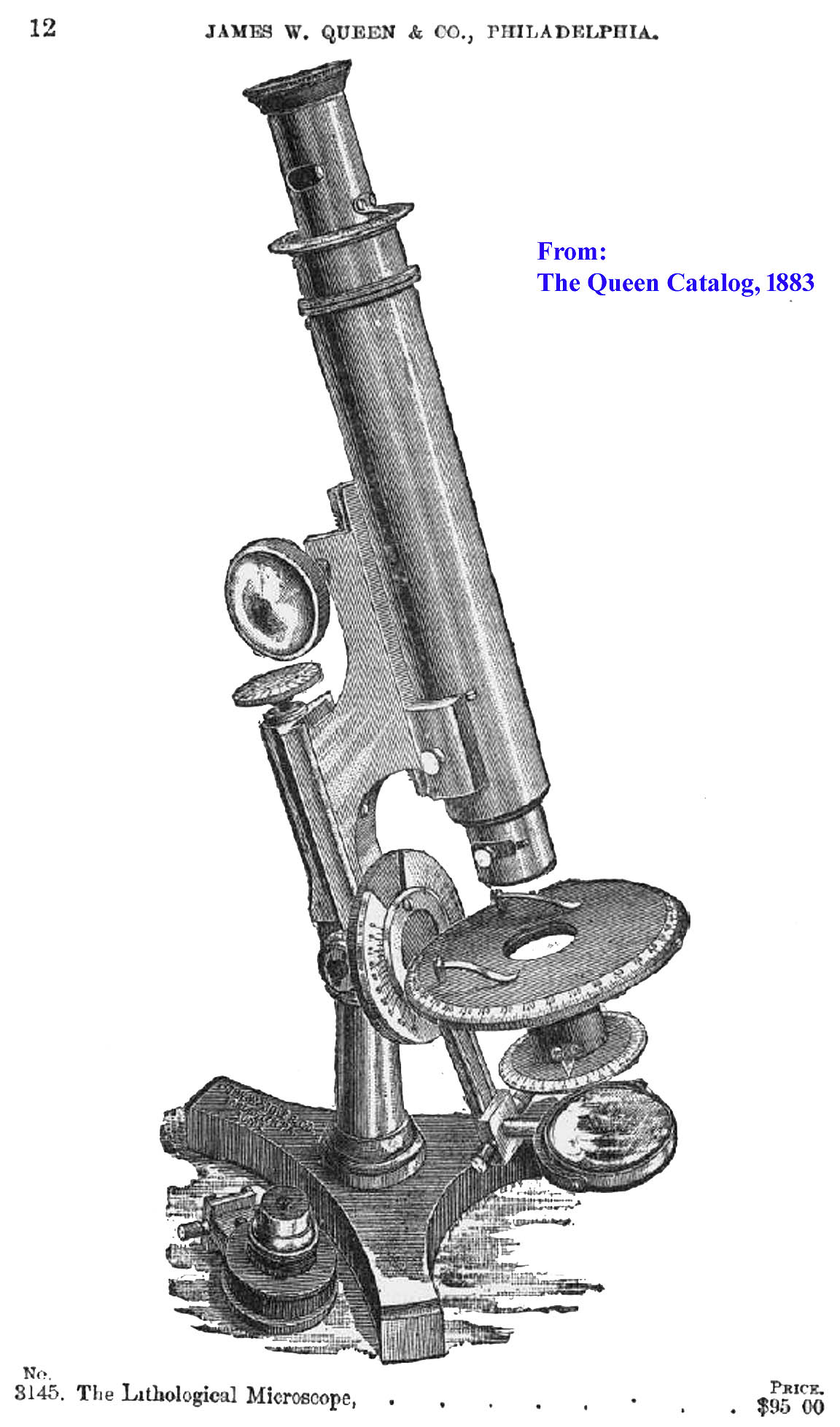
The Sidle Lithological
model was, according to the Sidle ad of April 1881, constructed after the pattern of the No 3
. It had a slide-out analyzer and slide-out Klein's Quartz plate in the tube. A second analyzer was integrated into a goniometer eyepiece with centering cross hairs which could receive a rotating double calspar plate for determining the position of planes of vibration of light in crystals. It was illustrated and described in the JRMS of 1881, pages 937-939.
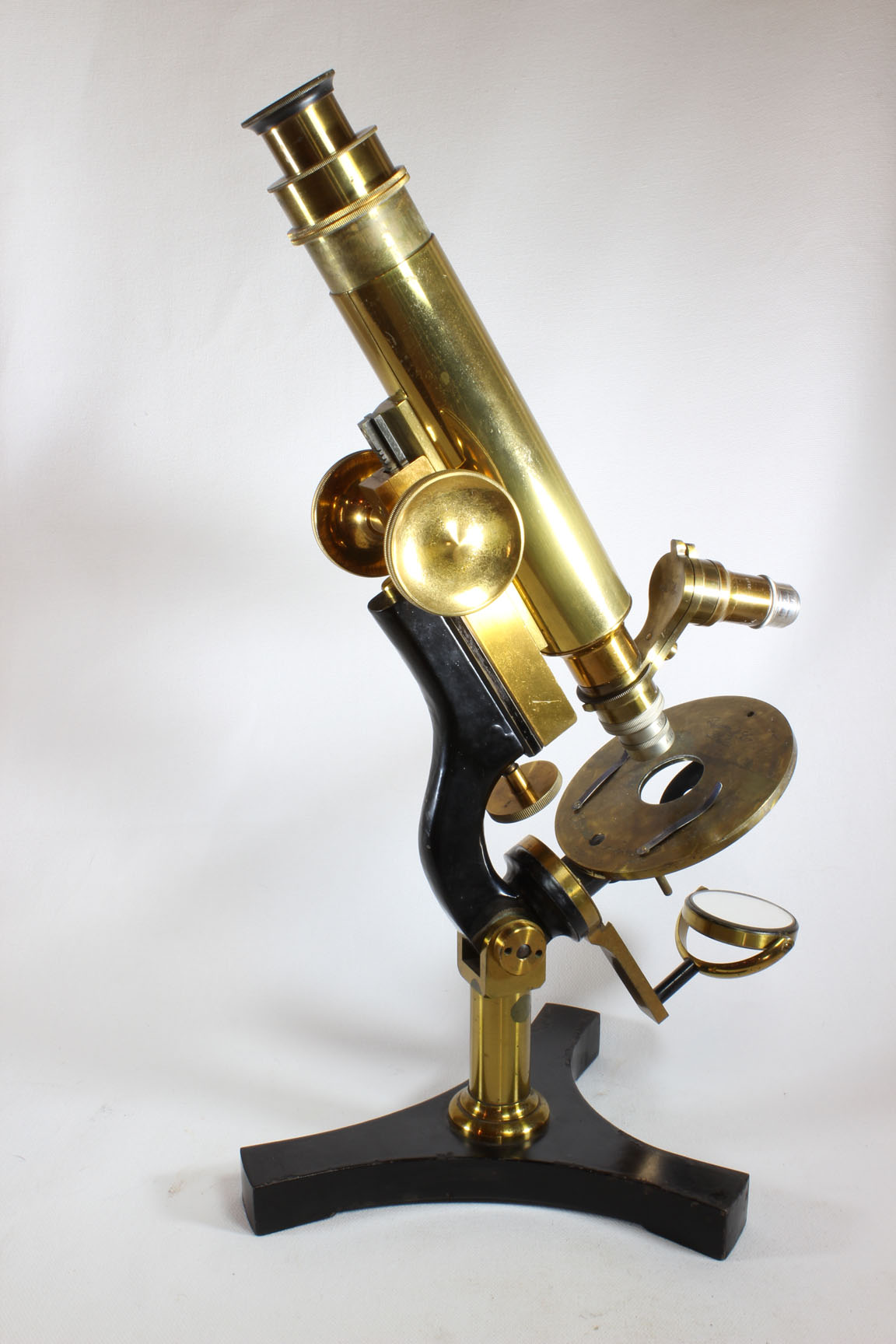
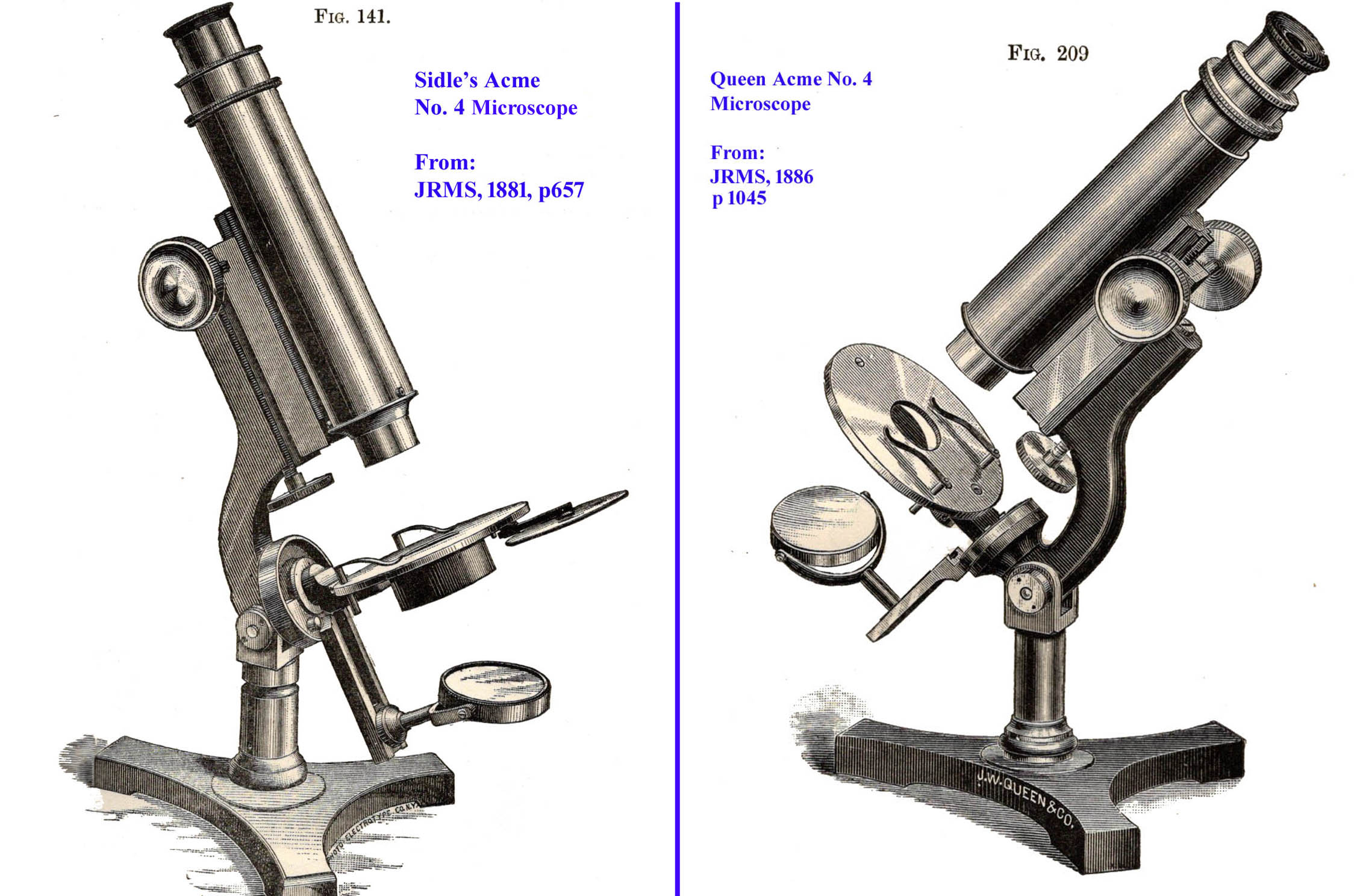
The Acme No. 4 was first illustrated and described in the 1880 volume of the Am Microscopical J, Vol 1, pages 9-10. A slightly modified form was also reported in the JRMS of 1881, p 657. This later version, marketed by Queen, with a thinner sector, slightly different limb, and black finish to the foot, pillar and part of the limb, was illustrated in the JRMS of 1886 and sold for many years after that, still listed in the Queen catalog of 1892. An example of the 1881 Queen No 4 is in this collection.
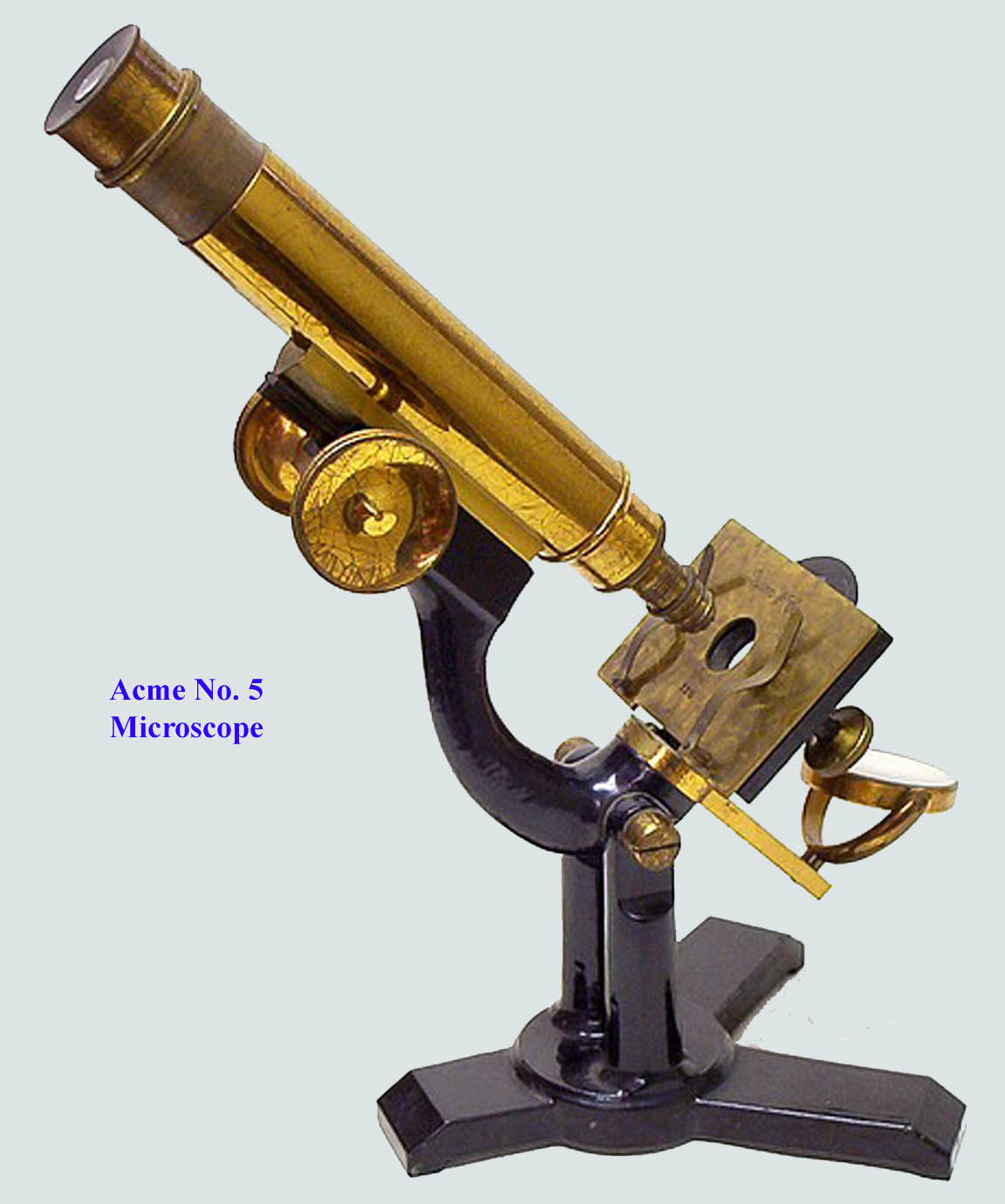
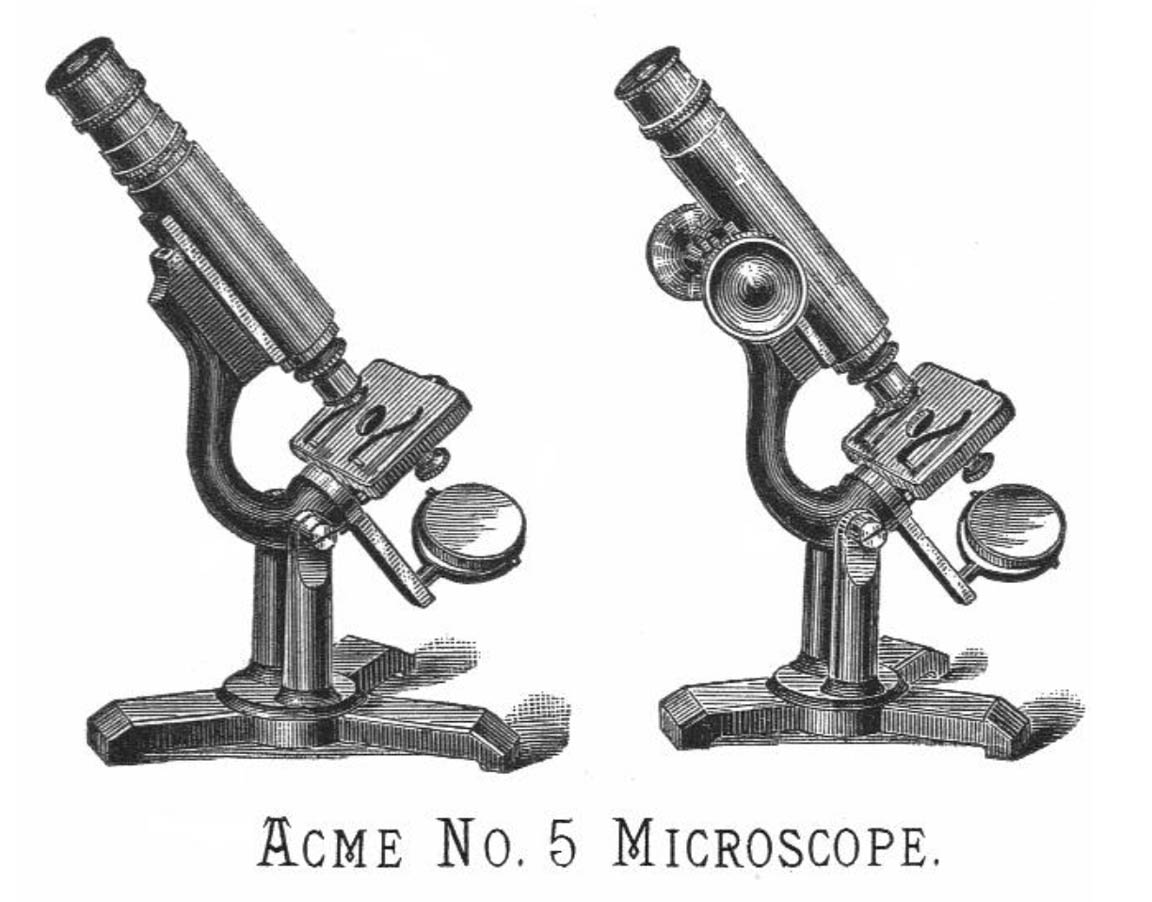
The Acme No. 5 was also sold by Queen starting in the late 1880s.An article in Scientific American of 18882 suggested that by that time, that year Acme
microscopes were made on the premises of Queen, but this model, and the No 6, shown below, were unlikely made by Queen. This microscope is unlike any of Sidle's microscopes and closely resembles the Bausch & Lomb Model Microscope
and the B & L Library Microscope
, which was also available with a tilting stage fine focus. It was initially offered with either push-pull coarse focus or rack and pinion coarse focus, both with tilting-stage fine focusing. Since Queen now had exclusive rights to the Acme brand, they were free to call this an Acme, but it is unlikely Sidle had any part in making it and Queen's part in making it and the No 6 is not established. The actual maker may have been B & L; Queen also sold microscopes signed by B & L.

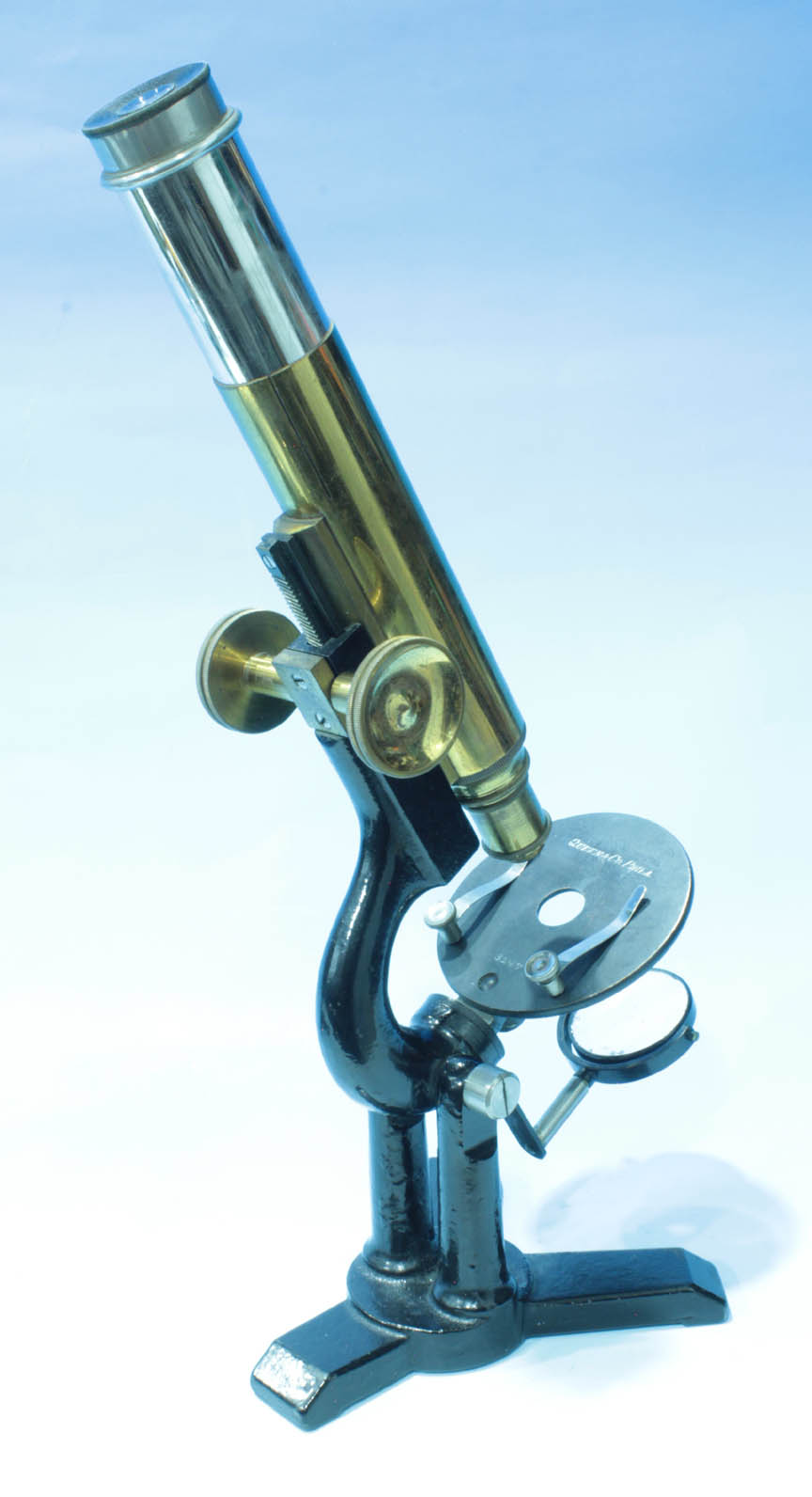
Sometime around 1900 the Acme No. 6 was introduced. It had a round stage without fine focus; the No 6 Acme microscope is very similar to one in this collection signed by McAllister and the Library Microscope made by and marketed directly by Bausch & Lomb from about 1886 to 1896, the same time period that the Acme No. 6 was marketed. In the 1893 Bausch & Lomb catalog, the Library model was offered with or without a tilting stage fine focus, thus similar to the Acme No 5. The Acme No. 6 in this collection(right) has diagonal rack and pinion whereas the instrument signed by McAllister, with more brass finishes, and therefore presumably a little older, has straight teeth on the rack and pinion. The feet and uprights are identical between the two. Also other than the finishes, the stage and inclination screws are also identical. The Acme No 6 has a black-finished longer slide for the optical tube, a slightly thicker limb, a more modern objective (unsigned), slightly different knurling to the focusing knobs, and the draw tube extends above its knurled lip. The mirror has a larger diameter on the Acme. It should be noted that Queen also retailed Bausch & Lomb microscopes signed by B & Lomb.
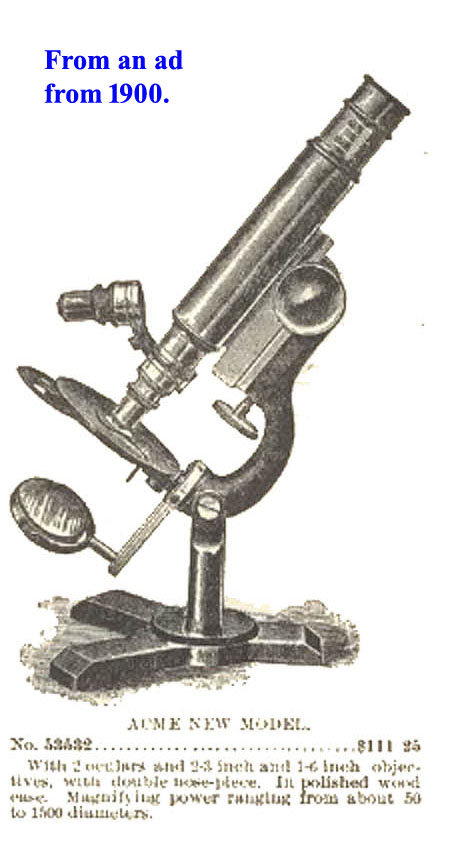
At the same time as the No 6 was being sold, the New Acme
was being sold, with the same foot and uprights with a round stage but with an under-the-limb fine focus and a substage wheel of apertures just like the old number 4. By 1892, Queen was advertising the New Acme Continental Microscopes
. It appears that sometime in the 1890s the original designs of Sidle were no longer offered.


The Acme Continental
microscope was apparently made in more than one form. In the ad to the left it had the Pennoch type of centerable substage; this microscope was called the Acme Continental IIa
. Another model, called an Acme Continental II
, and shown to the right, has a screw-focused substage and is virtually identical to the Bausch & Lomb BB8 model of the 1890s. Although sold by Queen, it was very likely made by Bausch & Lomb.
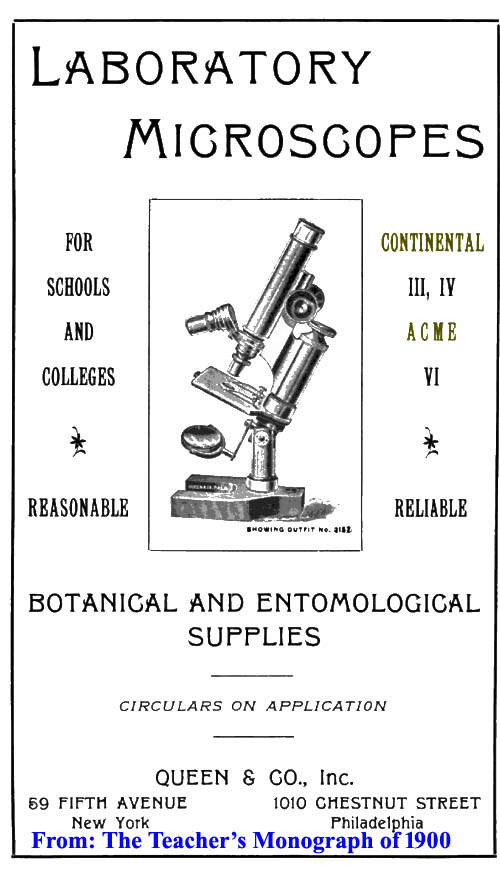
Apparently even simpler Continentals, without any substage, were also supplied at the beginning of the 20th century, in addition to the Acme Models No. 3, No. 4, and No. 6.
SOME ADDITIONAL HISTORY OF THE MICROSCOPE FEATURED ON THIS PAGE:
This microscope was sold at auction in Reno, Nevada in 2014, and then again at Auction in Cleveland, Ohio in May of 2024. It was then purchased by the author from a seller on Ebay in December of 2024 but apparently lost by the United States Postal Service in Overland Park, Kansas for over a month, but I finally received it. There is only one other example of this exact microscope that I know of, and that one(serial number 364), which had severely damaged tube lacquer, sold on Ebay in 2017. My microscope may have had a goniometer eyepiece, as did the other example, but this is unclear as a prior image did not show the goniometer on the analyzer of this instrument. It is possible the goniometer top on the other example(shown above in the Accessory Section), from serial number 364 was not original to it all as it looks like a circa 1900 Bausch & Lomb accessory*. What is apparent, is that these microscopes were equipped, not only for routine microscopy, but also for basic polarization work. The sophisticated system for centering the stage, as well as the substage was apparently limited to the Sidle No 2, not found on the other Sidle models that have come to light thus far. With these features, and in addition, the provision of not only a swinging substage, but a tilting as well as rotatable stage, made this the most complex microscope ever made by Sidle. It is among the most complex American microscopes of that era ever made. To my knowledge, it was never listed in the Queen catalogs or anywhere else other than by Sidle.
*Thanks to Dan Kile for pointing this out.
TIMETABLE OF SIDLE & POALK, SIDLE & CO., AND QUEEN MICROSCOPES:
August 19-24, 1879, John W. Sidle of Philadelphia, PA and Professor J Edwards Smith of Cleveland, Ohio met during the National Microscopical Congress in Indianapolis, Indiana where they devised a plan to produce the Acme line of microscopes designed to be of higher quality than others for the same price at that time. Sidle exhibits his “Congress” centering turntable for ringing microscope slides.
August 1879: First Acme microscope by Sidle & Poalk delivered .
November 21, 1879: G.S. Woolman exhibited the Acme microscope by Sidle & Poalk at the Regular Conversazione Meeting of the New York Microscopical Soc.
Summer 1880: Sidle & Poalk dissolved their partnership and Sidle relocated to Lancaster, PA, as Sidle & Company a.k.a. the Acme Optical Works. Sidle & Company was in business no later than September 1880.
November 1880: Sidle & Company No. 2 microscope illustrated and described in the Am Monthly Microscopical J. It was never listed in the Queen Catalogs, nor listed in any Queen advertisement I am aware of.
April 1881: Sidle & Company advertised the No 2, No 3, No 4, and Lithological Models in Science.
November 1, 1881: Sidle announced that from that date onward, Queen & Co were to be the sole sellers of Acme microscopes.
1882: Sidle & Company Class Microscope was shown in the JRMS but not listed in the Queen Catalog.
1886: Queen & Co was said to have taken over all production of Acme microscopes.
1888: Queen & Company advertised the No 5, microscope, unlike any Sidle design and using a foot and upright design of Bausch & Lomb.
1892: Queen advertised their Continental Models and also the “New Acme” microscope.
1900: Queen selling the Acme Nos. 3,4, and 6, as well as Continentals.
1888-1918: Sidle made and sold telescopes and especially telescopic gunsights.
December 23, 1918: Sidle dies in California.
REFERENCES:
1. Smith, J.E, 1880: How to Work with the Microscope pages 84-90.
2. Anonymous, 1888: Scientific American LVIII, No 16, 257-258 The Manufacture of Scientific Apparatus.


































